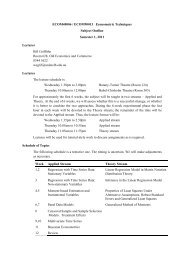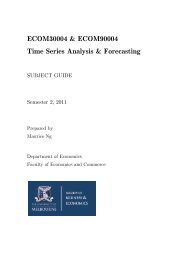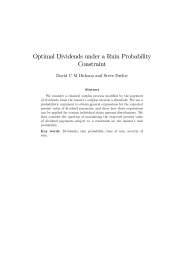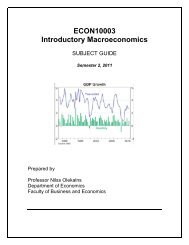A Model of Optimal Corporate Bailouts - Faculty of Business and ...
A Model of Optimal Corporate Bailouts - Faculty of Business and ...
A Model of Optimal Corporate Bailouts - Faculty of Business and ...
Create successful ePaper yourself
Turn your PDF publications into a flip-book with our unique Google optimized e-Paper software.
Under this tax regime, however, it must still be optimal for the firm to invest in the first period, i.e.,I 1 ≤ e1· R ∗ − c·e ∗ 1 − T ∗1 = c·e∗ 2 1.This is equivalent toR − R24·c + I 2 + 8·I 1 ≤ I ∗ 1 ≡This is the third condition in the theorem.R 24·c − I 216·c 2 2c + R − R24·c + I 2Thus far, we have demonstrated conditions that ensure a bailout is feasible, incentive compatible,financible, <strong>and</strong> potentially welfare enhancing. Although each condition is necessary for a non-zerobailout to exist, they become sufficient if the bailout is welfare enhancing. The fourth condition in thetheorem compares whether the optimal non-zero bailout is socially preferable to non-intervention. Thatis, it must be the case that the social value (SV from eq. 2), with e 1 = e ∗ 1 = (R − T ∗ 1)/(2·c) (from eq. A.4,assuming that the manager is fired) <strong>and</strong> T 1 = T ∗ 1(from eq. A.5, again assuming that the manager isfired), <strong>and</strong> e 2 = e ∗ 2 = R/(2·c) exceeds social value without intervention, i.e., sv 1 (eq. 1), with e 1 = R/(2·c)(from eq. 4). The condition that g > 0 in the theorem assures that the firm would shut down in theabsence <strong>of</strong> intervention. The critical minimum S for which government intervention is feasible is thenwhere e ∗ 1is defined in (A.4). 2·cS =·(1 − e∗ 1 )·I ∗ 3·R22 − e1·(R −8·c ) + c·e∗2 1 /2, (A.6)2·c − Re ∗ 1.A.7 Pro<strong>of</strong> <strong>of</strong> Corollary 1As defined in (A.3), the budget (which has to be weakly positive according to (BB)) isF( T ) = 12·c · (R − T 1 )·T 1 − (2·c − R + T 1 )·g .Furthermore, there are two values <strong>of</strong> T ∗ 1 such that F( T ∗ 1 ) = 0 if [(R + g)2 − 8·c·g] > 0. However, thelower value <strong>of</strong> T ∗ 1 is socially desirable, because it leads to higher managerial effort, e 1. From the pro<strong>of</strong> <strong>of</strong>Lemma 4, we also know that F( T 1 ) first increases in T 1 , then decreases in T 1 . Consequently, F T ∗1> 0 atthe lower <strong>of</strong> the two values <strong>of</strong> T ∗ 1. The comparative-statics results then follow from the Implicit FunctionTheorem, the fact that g ∗ = I 2 − R24·c , <strong>and</strong> F R = T 1 + I 2 − R2+ R4·c 2·c ·(2·c − R + T 1) > 0F I2= −(2·c − R + T 1 ) < 0, <strong>and</strong> F c = −2· I 2 − R2− R24·c 4·c 2 ·(2·c − R + T 1) < 0 .(The optimal tax <strong>and</strong> intervention are not functions <strong>of</strong> social surplus S if the government bails out thefirm. It is not valuable for the government to subsidize more than g ∗ , regardless <strong>of</strong> how large S is.)35
















